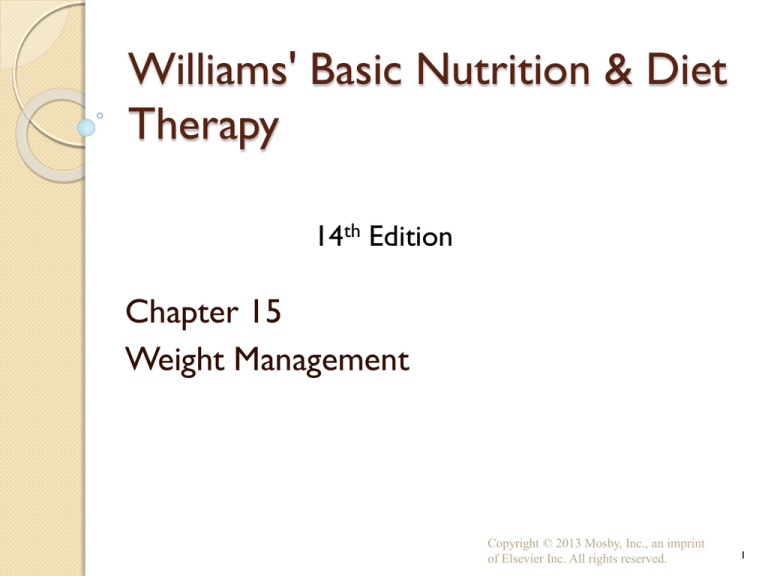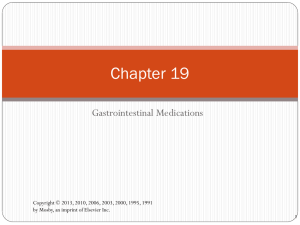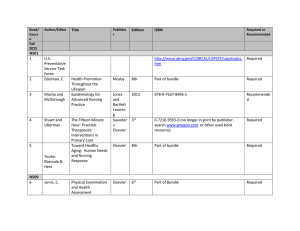
Williams' Basic Nutrition & Diet
Therapy
14th Edition
Chapter 15
Weight Management
Copyright © 2013 Mosby, Inc., an imprint
of Elsevier Inc. All rights reserved.
1
Causes of Obesity and Risks of
Food Fads
Underlying causes of obesity include a
host of various genetic, environmental,
and psychological factors.
Short-term food patterns, or fads, often
stem from food misinformation that
appeals to some human psychological
need but does not necessarily meet
physiologic needs.
Copyright © 2013 Mosby, Inc., an imprint
of Elsevier Inc. All rights reserved.
2
Introduction (p. 280)
Currently in the United States
◦
◦
◦
◦
34.2% of adults are overweight
33.8% are obese
5.7% are extremely obese
16.9% of children and adolescents are obese
Copyright © 2013 Mosby, Inc., an imprint
of Elsevier Inc. All rights reserved.
3
Introduction (cont’d) (p. 280)
Copyright © 2013 Mosby, Inc., an imprint
of Elsevier Inc. All rights reserved.
4
Obesity and Weight Control
(p. 280)
Body weight and body fat
◦ Definitions
◦ Body composition
Measures of weight maintenance goals
◦ Standard height/weight tables
◦ Healthy weight range
Individual variation
Necessity of body fat
Copyright © 2013 Mosby, Inc., an imprint
of Elsevier Inc. All rights reserved.
5
BMI classification
18.5-24.9: normal
25-29.9: OVERWEIGHT*
30-35: Obese
>35: clinically or extremely obese
Individuals with more muscle mass than
the average person, BMI may not be ideal
◦ Use body composition*
Copyright © 2013, 2009, 2005 Mosby, Inc.,
an imprint of Elsevier Inc. All rights
reserved.
Body Composition
Body fat calipers
Hydrostatic weight*
Bioelectrical impedance analysis
Dual energy x-ray absorptiometry
Body fat content in the range of 21-25.8%
of total body weight is associated with
lowest risk of chronic disease for men
ages 20-79; women range is 32.2-36.9%
To measure the total body fat content,
take weight and multiply by 32.2-36.9%**
Copyright © 2013, 2009, 2005 Mosby, Inc.,
an imprint of Elsevier Inc. All rights
reserved.
American college of sports
medicine
Classifies men as having above average
and well above average fitness levels when
their body fat percentages are between 715.8% for 20-29 year old men **
Copyright © 2013, 2009, 2005 Mosby, Inc.,
an imprint of Elsevier Inc. All rights
reserved.
Obesity and Health (p. 286)
Weight extremes: clinically severe obesity
is health hazard**
Overweight and health problems:
hypertension, diabetes, heart disease,
arthritis, cancer**
Clinically significant obesity is a BMI of 40
or more or a body mass index of 35-39
with at least one obesity-related
disorder**
Copyright © 2013 Mosby, Inc., an imprint
of Elsevier Inc. All rights reserved.
9
Causes of Obesity (p. 286)
Basic energy balance
◦ *physical inactivity
Hormonal control: leptin and ghrelin*
◦ Ghrelin is an appetite stimulant*
◦ *leptin thought to play a role in determining a
persons set point for fat storage
Copyright © 2013 Mosby, Inc., an imprint
of Elsevier Inc. All rights reserved.
10
Causes of Obesity
Genetic and family factors
◦ Genetic control: obesity highly associated with
genetics**
Predisposition for obesity is associated with genetics,
making certain people highly susceptible to becoming
obese in an environment that allows for such a genetic
expression**
◦ Family reinforcement: teach food habits and exert
social pressure**
◦ Physiologic factors: number of fat cells in the
body**
Yo-yo dieting*
◦ Other environmental factors: availability of
energy-dense, fast foods, convenient foods
Copyright © 2013 Mosby, Inc., an imprint
of Elsevier Inc. All rights reserved.
11
Individual Differences and Extreme
Practices (p. 288)
Individual energy balance levels
Extreme practices
◦ Fad diets
◦ Scientific inaccuracies and misinformation
◦ Failure to address the necessity of changing
long-term habits
Copyright © 2013 Mosby, Inc., an imprint
of Elsevier Inc. All rights reserved.
12
Extreme Practices (p. 289)
**Fasting: negative health effects, rebound
effect
Specific macronutrient restrictions: no
evidence to support, carry health risks
**Clothing and body wraps: cause
temporary water loss
Drugs: FDA regulates, should be
combined with lifestyle changes
◦ *orlistat (Alli, Xenical) for treatment of
clinically significant obesity in 1999,
Copyright © 2013 Mosby, Inc., an imprint
of Elsevier Inc. All rights reserved.
13
Extreme Practices
Surgery: gastric restriction, malabsorptive
procedures, lipectomy
◦ Reserved for medical treatment of clinically
severe obesity among patients who have not
had success with other methods of long-term
weight loss**
◦ *risks, side effects and complications
Copyright © 2013, 2009, 2005 Mosby, Inc.,
an imprint of Elsevier Inc. All rights
reserved.
Surgical Treatments for Obesity (p.
293)
Copyright © 2013 Mosby, Inc., an imprint
of Elsevier Inc. All rights reserved.
15
Weight Management Tools and Risks of
Being Underweight
Weight loss requires hard work and strong
physical motivation*
Realistic weight management focuses on
individual needs and health promotion,
including meal pattern planning and regular
physical activity.
Severe underweight carries physiologic and
psychological risk to the body.
Copyright © 2013 Mosby, Inc., an imprint
of Elsevier Inc. All rights reserved.
16
A Sound Weight Management
Program (p. 294)
Essential characteristics: food and
exercise behaviors
*Behavior modification
◦ Basic principles-empowering individuals to
plan constructive actions to meet personal
health goals**
◦ Basic strategies and actions
Defining problem behavior
Recording and analyzing baseline behavior
Planning behavior management strategy
Copyright © 2013 Mosby, Inc., an imprint
of Elsevier Inc. All rights reserved.
17
Weight loss strategies
Control eating behavior**
*small portions
Exercise
Copyright © 2013, 2009, 2005 Mosby, Inc.,
an imprint of Elsevier Inc. All rights
reserved.
Dietary Principles (p. 294)
Dietary principles
◦ **Realistic goals: ½ to 1 lb per week loss
◦ Negative energy balance: 500 to 1000 kcal/day
◦ Nutritional adequacy: choose nutrient-dense
foods
◦ Cultural appeal: to allow permanent change in
habits
◦ Energy readjustment to maintain weight: when
desired weight is reached
Copyright © 2013 Mosby, Inc., an imprint
of Elsevier Inc. All rights reserved.
19
Basic Energy Balance Components
(p. 295)
Energy input: food behaviors
Energy output: exercise behaviors
Copyright © 2013 Mosby, Inc., an imprint
of Elsevier Inc. All rights reserved.
20
Principles of a Sound Food Plan (p.
296)
Energy balance: modifications to energy intake and
output
◦ 1 pound of fat is equal to approx 3500 kcal, energy deficit
of 500 kcal/day results in a weight loss of about 1
pound/wk**
Nutrient balance: (macronutrients) carbohydrate,
protein, fat proportions*
Distribution balance: spread food throughout the
day
Food guide: American Dietetic Association
Preventive approach: overweight children become
obese adults
Copyright © 2013 Mosby, Inc., an imprint
of Elsevier Inc. All rights reserved.
21
Food Misinformation and Fads (p.
300)
Types of claims
◦ Food cures: certain foods cure specific
conditions
◦ Harmful foods: certain foods are harmful
◦ Food combinations: specific combinations
restore health
◦ “Natural” foods: only “natural” foods can
meet body needs
Copyright © 2013 Mosby, Inc., an imprint
of Elsevier Inc. All rights reserved.
22
Food Misinformation and Fads
(cont’d) (p. 301)
Erroneous claims
Dangers
◦
◦
◦
◦
To health
Often expensive
Perpetuates superstitions
Distrust of modern food market
Vulnerable groups
◦ Elderly, young persons, obese persons, athletes
and coaches, entertainers
Copyright © 2013 Mosby, Inc., an imprint
of Elsevier Inc. All rights reserved.
23
Underweight (p. 302)
**General causes
◦
◦
◦
◦
◦
◦
Wasting disease
Poor food intake
Malabsorption
Hormonal imbalance
Energy imbalance
Poor living situation
Copyright © 2013 Mosby, Inc., an imprint
of Elsevier Inc. All rights reserved.
24
Dietary Treatment (p. 303)
High-calorie diet
High protein
High carbohydrate
Moderate fat
Adequate sources of vitamins and minerals
Copyright © 2013 Mosby, Inc., an imprint
of Elsevier Inc. All rights reserved.
25
Disordered Eating (p. 303)
Definition of normal eating
Disordered eating
◦ Anorexia nervosa: results in self-imposed
starvation
◦ Bulimia nervosa: binge-and-purge cycle
◦ Binge eating disorder: often follows stress or
anxiety
◦ Significant mortality rates, slow recovery
◦ Treatment
Copyright © 2013 Mosby, Inc., an imprint
of Elsevier Inc. All rights reserved.
26
ANOREXIA
*body dysmorphic disorder
Negative self-evaluation
s/s
◦ Hypotension, amenorrhea, anemia, menstrual
irregularities*
Copyright © 2013, 2009, 2005 Mosby, Inc.,
an imprint of Elsevier Inc. All rights
reserved.
Bulimia
Eating disorder that involves repeated
episodes of binge eating followed by one
or more compensatory mechanisms to
rid the body of excess calories**
s/s
◦ Dental caries, tooth erosion**
Copyright © 2013, 2009, 2005 Mosby, Inc.,
an imprint of Elsevier Inc. All rights
reserved.





